Wound Management: Application of Principles in Clinical Practice
VerifiedAdded on 2023/06/10
|13
|2065
|95
Report
AI Summary
This report provides a comprehensive overview of wound management principles and their application within a clinical environment. It details the four stages of wound healing: homeostasis, inflammation, proliferation and granulation, and maturation and epithelialization, explaining the key processes and factors involved in each stage. The report also addresses critical aspects of wound care, including factors that impede healing, principles of primary healthcare, national safety and quality standards, and infection control measures. Specific topics covered include the chain of infection, sterile field maintenance, and precautions related to wound care practices. Furthermore, the report discusses the historical development of pressure ulcer care, key components of wound care services, and pain management strategies in wound care, offering a holistic understanding of effective wound management in clinical practice. This detailed analysis is available for students on Desklib, along with a wealth of other solved assignments and study resources.
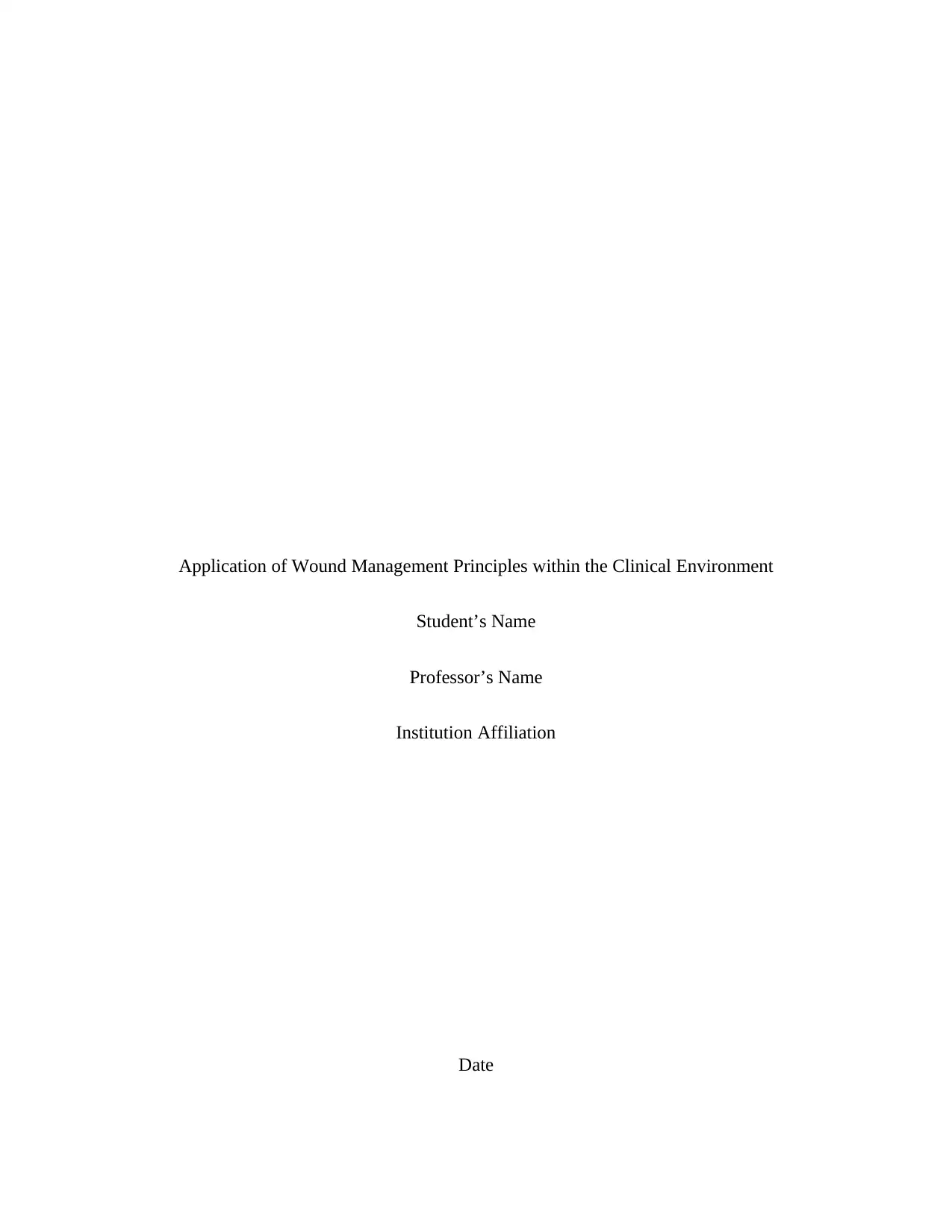
Application of Wound Management Principles within the Clinical Environment
Student’s Name
Professor’s Name
Institution Affiliation
Date
Student’s Name
Professor’s Name
Institution Affiliation
Date
Paraphrase This Document
Need a fresh take? Get an instant paraphrase of this document with our AI Paraphraser
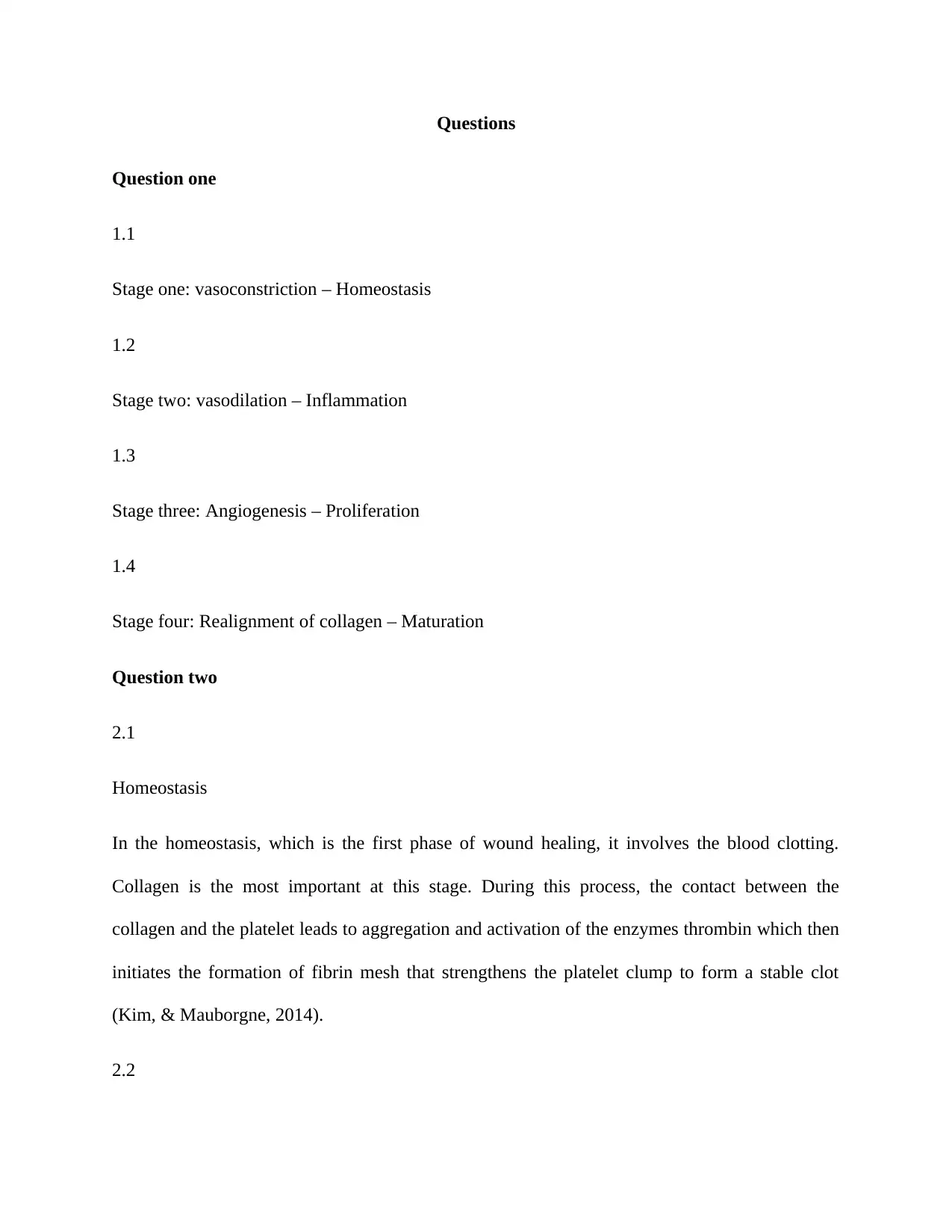
Questions
Question one
1.1
Stage one: vasoconstriction – Homeostasis
1.2
Stage two: vasodilation – Inflammation
1.3
Stage three: Angiogenesis – Proliferation
1.4
Stage four: Realignment of collagen – Maturation
Question two
2.1
Homeostasis
In the homeostasis, which is the first phase of wound healing, it involves the blood clotting.
Collagen is the most important at this stage. During this process, the contact between the
collagen and the platelet leads to aggregation and activation of the enzymes thrombin which then
initiates the formation of fibrin mesh that strengthens the platelet clump to form a stable clot
(Kim, & Mauborgne, 2014).
2.2
Question one
1.1
Stage one: vasoconstriction – Homeostasis
1.2
Stage two: vasodilation – Inflammation
1.3
Stage three: Angiogenesis – Proliferation
1.4
Stage four: Realignment of collagen – Maturation
Question two
2.1
Homeostasis
In the homeostasis, which is the first phase of wound healing, it involves the blood clotting.
Collagen is the most important at this stage. During this process, the contact between the
collagen and the platelet leads to aggregation and activation of the enzymes thrombin which then
initiates the formation of fibrin mesh that strengthens the platelet clump to form a stable clot
(Kim, & Mauborgne, 2014).
2.2
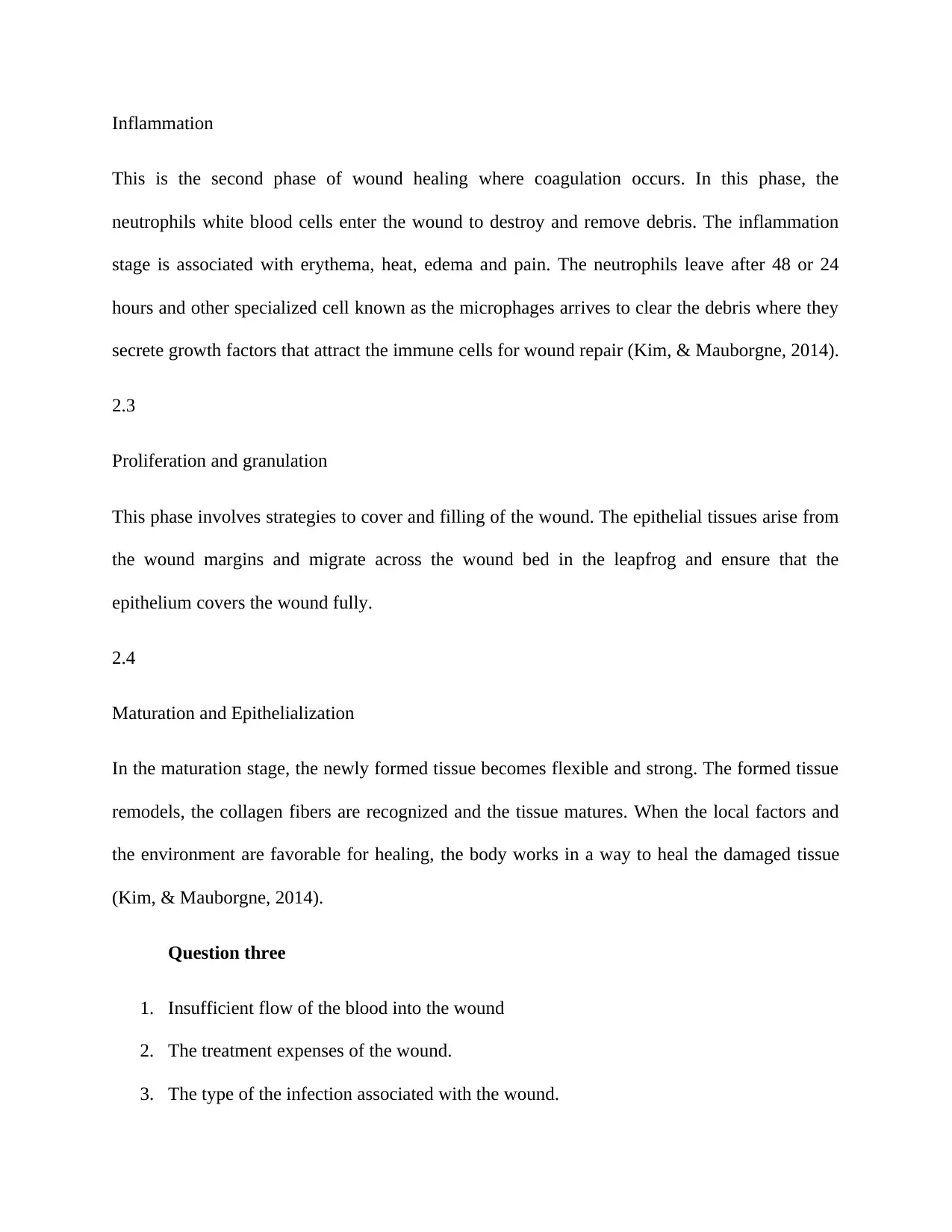
Inflammation
This is the second phase of wound healing where coagulation occurs. In this phase, the
neutrophils white blood cells enter the wound to destroy and remove debris. The inflammation
stage is associated with erythema, heat, edema and pain. The neutrophils leave after 48 or 24
hours and other specialized cell known as the microphages arrives to clear the debris where they
secrete growth factors that attract the immune cells for wound repair (Kim, & Mauborgne, 2014).
2.3
Proliferation and granulation
This phase involves strategies to cover and filling of the wound. The epithelial tissues arise from
the wound margins and migrate across the wound bed in the leapfrog and ensure that the
epithelium covers the wound fully.
2.4
Maturation and Epithelialization
In the maturation stage, the newly formed tissue becomes flexible and strong. The formed tissue
remodels, the collagen fibers are recognized and the tissue matures. When the local factors and
the environment are favorable for healing, the body works in a way to heal the damaged tissue
(Kim, & Mauborgne, 2014).
Question three
1. Insufficient flow of the blood into the wound
2. The treatment expenses of the wound.
3. The type of the infection associated with the wound.
This is the second phase of wound healing where coagulation occurs. In this phase, the
neutrophils white blood cells enter the wound to destroy and remove debris. The inflammation
stage is associated with erythema, heat, edema and pain. The neutrophils leave after 48 or 24
hours and other specialized cell known as the microphages arrives to clear the debris where they
secrete growth factors that attract the immune cells for wound repair (Kim, & Mauborgne, 2014).
2.3
Proliferation and granulation
This phase involves strategies to cover and filling of the wound. The epithelial tissues arise from
the wound margins and migrate across the wound bed in the leapfrog and ensure that the
epithelium covers the wound fully.
2.4
Maturation and Epithelialization
In the maturation stage, the newly formed tissue becomes flexible and strong. The formed tissue
remodels, the collagen fibers are recognized and the tissue matures. When the local factors and
the environment are favorable for healing, the body works in a way to heal the damaged tissue
(Kim, & Mauborgne, 2014).
Question three
1. Insufficient flow of the blood into the wound
2. The treatment expenses of the wound.
3. The type of the infection associated with the wound.
⊘ This is a preview!⊘
Do you want full access?
Subscribe today to unlock all pages.

Trusted by 1+ million students worldwide
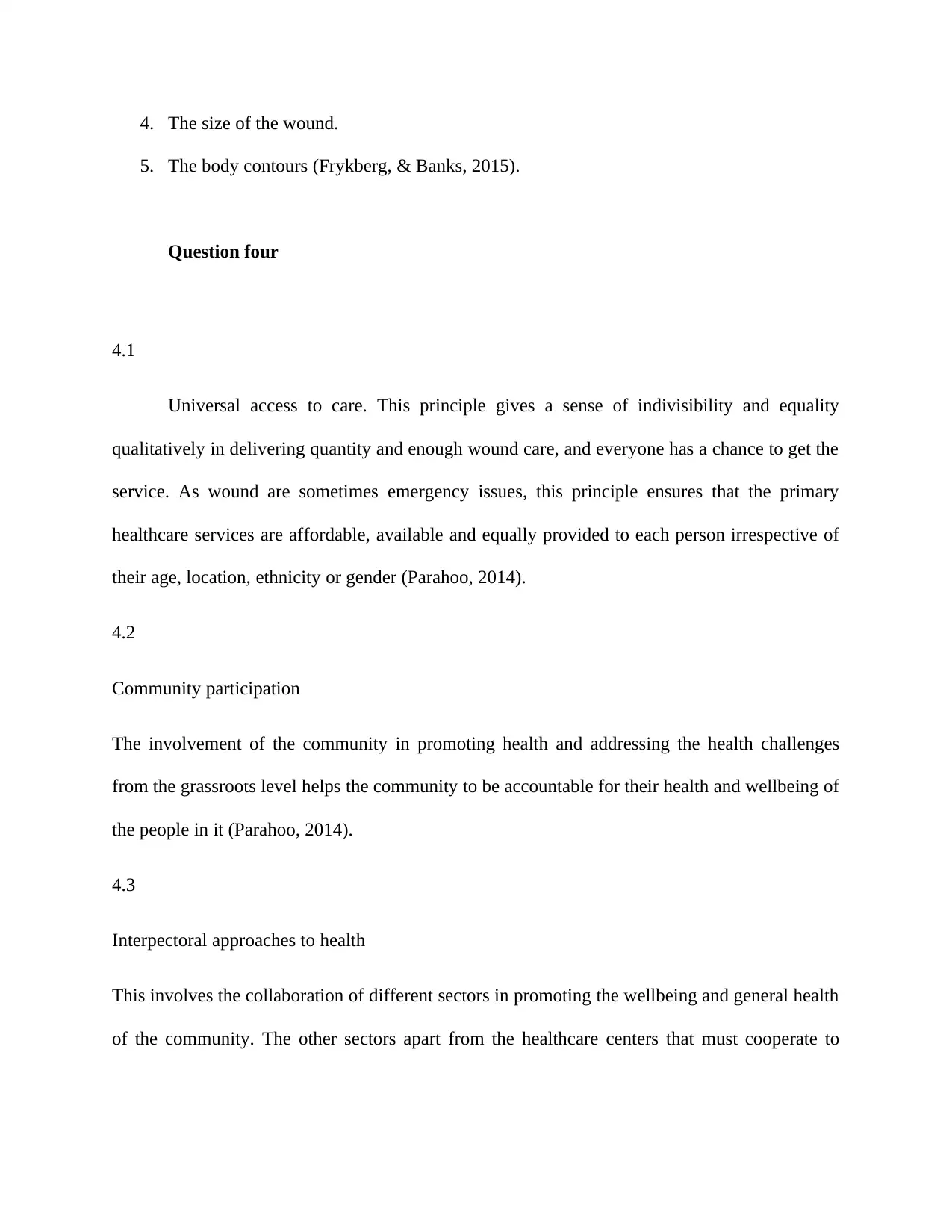
4. The size of the wound.
5. The body contours (Frykberg, & Banks, 2015).
Question four
4.1
Universal access to care. This principle gives a sense of indivisibility and equality
qualitatively in delivering quantity and enough wound care, and everyone has a chance to get the
service. As wound are sometimes emergency issues, this principle ensures that the primary
healthcare services are affordable, available and equally provided to each person irrespective of
their age, location, ethnicity or gender (Parahoo, 2014).
4.2
Community participation
The involvement of the community in promoting health and addressing the health challenges
from the grassroots level helps the community to be accountable for their health and wellbeing of
the people in it (Parahoo, 2014).
4.3
Interpectoral approaches to health
This involves the collaboration of different sectors in promoting the wellbeing and general health
of the community. The other sectors apart from the healthcare centers that must cooperate to
5. The body contours (Frykberg, & Banks, 2015).
Question four
4.1
Universal access to care. This principle gives a sense of indivisibility and equality
qualitatively in delivering quantity and enough wound care, and everyone has a chance to get the
service. As wound are sometimes emergency issues, this principle ensures that the primary
healthcare services are affordable, available and equally provided to each person irrespective of
their age, location, ethnicity or gender (Parahoo, 2014).
4.2
Community participation
The involvement of the community in promoting health and addressing the health challenges
from the grassroots level helps the community to be accountable for their health and wellbeing of
the people in it (Parahoo, 2014).
4.3
Interpectoral approaches to health
This involves the collaboration of different sectors in promoting the wellbeing and general health
of the community. The other sectors apart from the healthcare centers that must cooperate to
Paraphrase This Document
Need a fresh take? Get an instant paraphrase of this document with our AI Paraphraser
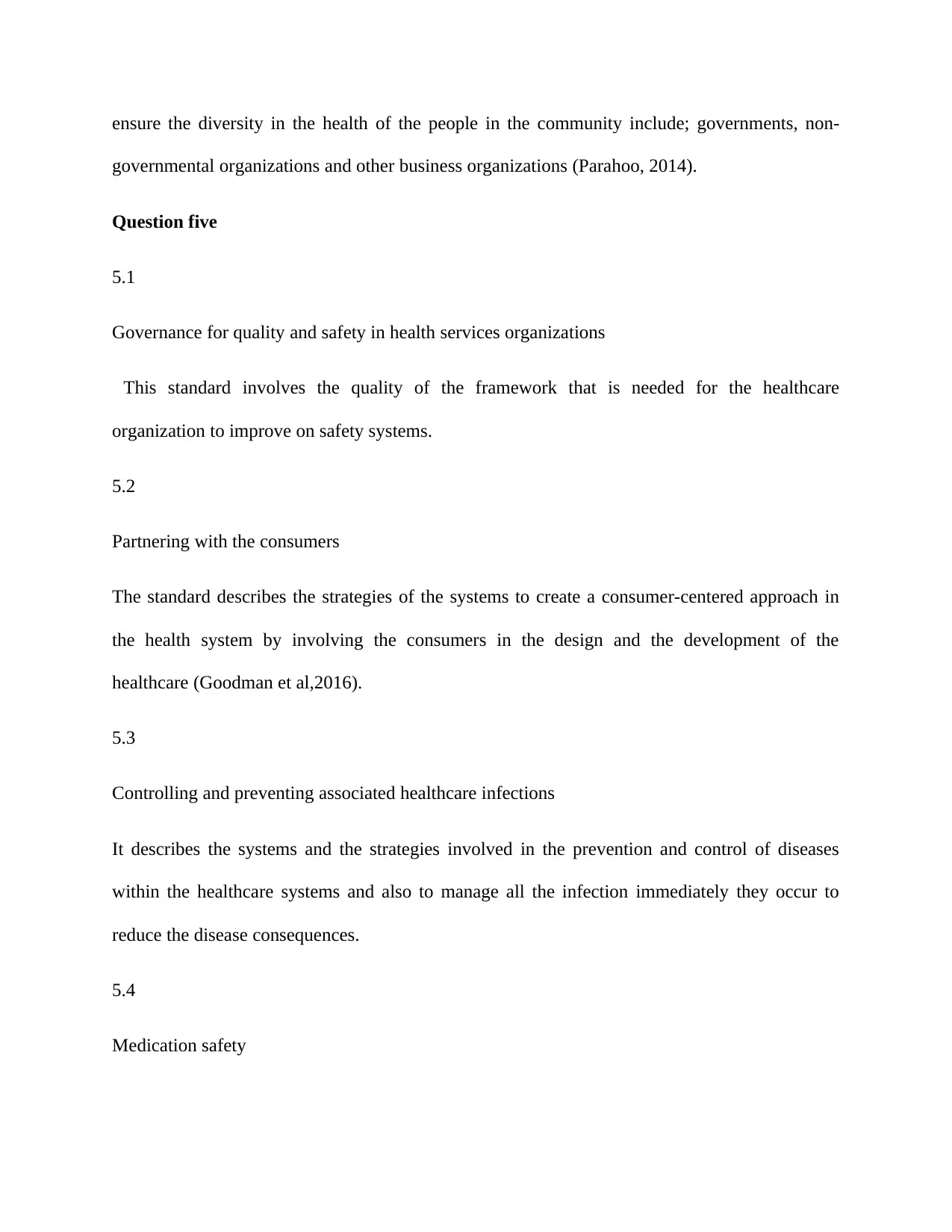
ensure the diversity in the health of the people in the community include; governments, non-
governmental organizations and other business organizations (Parahoo, 2014).
Question five
5.1
Governance for quality and safety in health services organizations
This standard involves the quality of the framework that is needed for the healthcare
organization to improve on safety systems.
5.2
Partnering with the consumers
The standard describes the strategies of the systems to create a consumer-centered approach in
the health system by involving the consumers in the design and the development of the
healthcare (Goodman et al,2016).
5.3
Controlling and preventing associated healthcare infections
It describes the systems and the strategies involved in the prevention and control of diseases
within the healthcare systems and also to manage all the infection immediately they occur to
reduce the disease consequences.
5.4
Medication safety
governmental organizations and other business organizations (Parahoo, 2014).
Question five
5.1
Governance for quality and safety in health services organizations
This standard involves the quality of the framework that is needed for the healthcare
organization to improve on safety systems.
5.2
Partnering with the consumers
The standard describes the strategies of the systems to create a consumer-centered approach in
the health system by involving the consumers in the design and the development of the
healthcare (Goodman et al,2016).
5.3
Controlling and preventing associated healthcare infections
It describes the systems and the strategies involved in the prevention and control of diseases
within the healthcare systems and also to manage all the infection immediately they occur to
reduce the disease consequences.
5.4
Medication safety
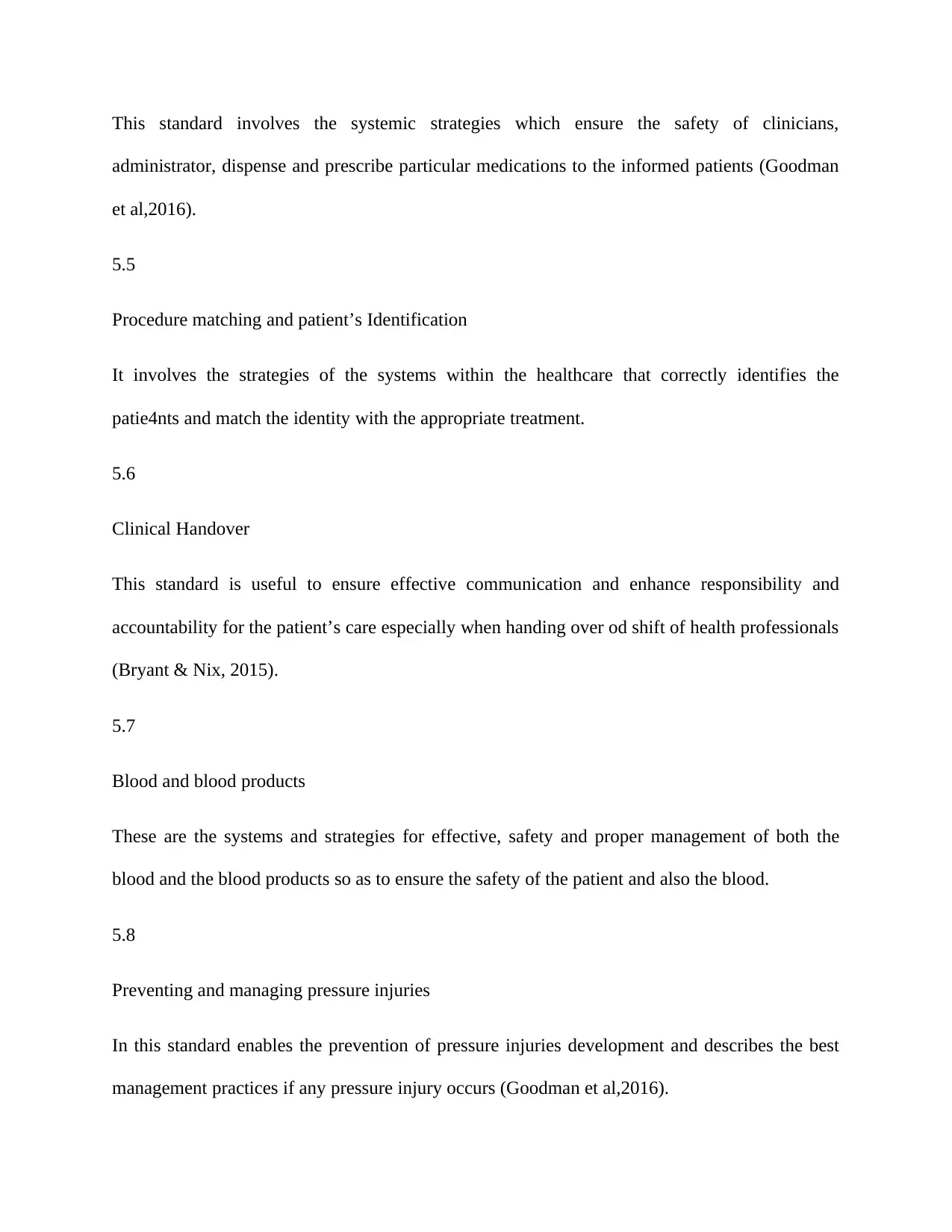
This standard involves the systemic strategies which ensure the safety of clinicians,
administrator, dispense and prescribe particular medications to the informed patients (Goodman
et al,2016).
5.5
Procedure matching and patient’s Identification
It involves the strategies of the systems within the healthcare that correctly identifies the
patie4nts and match the identity with the appropriate treatment.
5.6
Clinical Handover
This standard is useful to ensure effective communication and enhance responsibility and
accountability for the patient’s care especially when handing over od shift of health professionals
(Bryant & Nix, 2015).
5.7
Blood and blood products
These are the systems and strategies for effective, safety and proper management of both the
blood and the blood products so as to ensure the safety of the patient and also the blood.
5.8
Preventing and managing pressure injuries
In this standard enables the prevention of pressure injuries development and describes the best
management practices if any pressure injury occurs (Goodman et al,2016).
administrator, dispense and prescribe particular medications to the informed patients (Goodman
et al,2016).
5.5
Procedure matching and patient’s Identification
It involves the strategies of the systems within the healthcare that correctly identifies the
patie4nts and match the identity with the appropriate treatment.
5.6
Clinical Handover
This standard is useful to ensure effective communication and enhance responsibility and
accountability for the patient’s care especially when handing over od shift of health professionals
(Bryant & Nix, 2015).
5.7
Blood and blood products
These are the systems and strategies for effective, safety and proper management of both the
blood and the blood products so as to ensure the safety of the patient and also the blood.
5.8
Preventing and managing pressure injuries
In this standard enables the prevention of pressure injuries development and describes the best
management practices if any pressure injury occurs (Goodman et al,2016).
⊘ This is a preview!⊘
Do you want full access?
Subscribe today to unlock all pages.

Trusted by 1+ million students worldwide
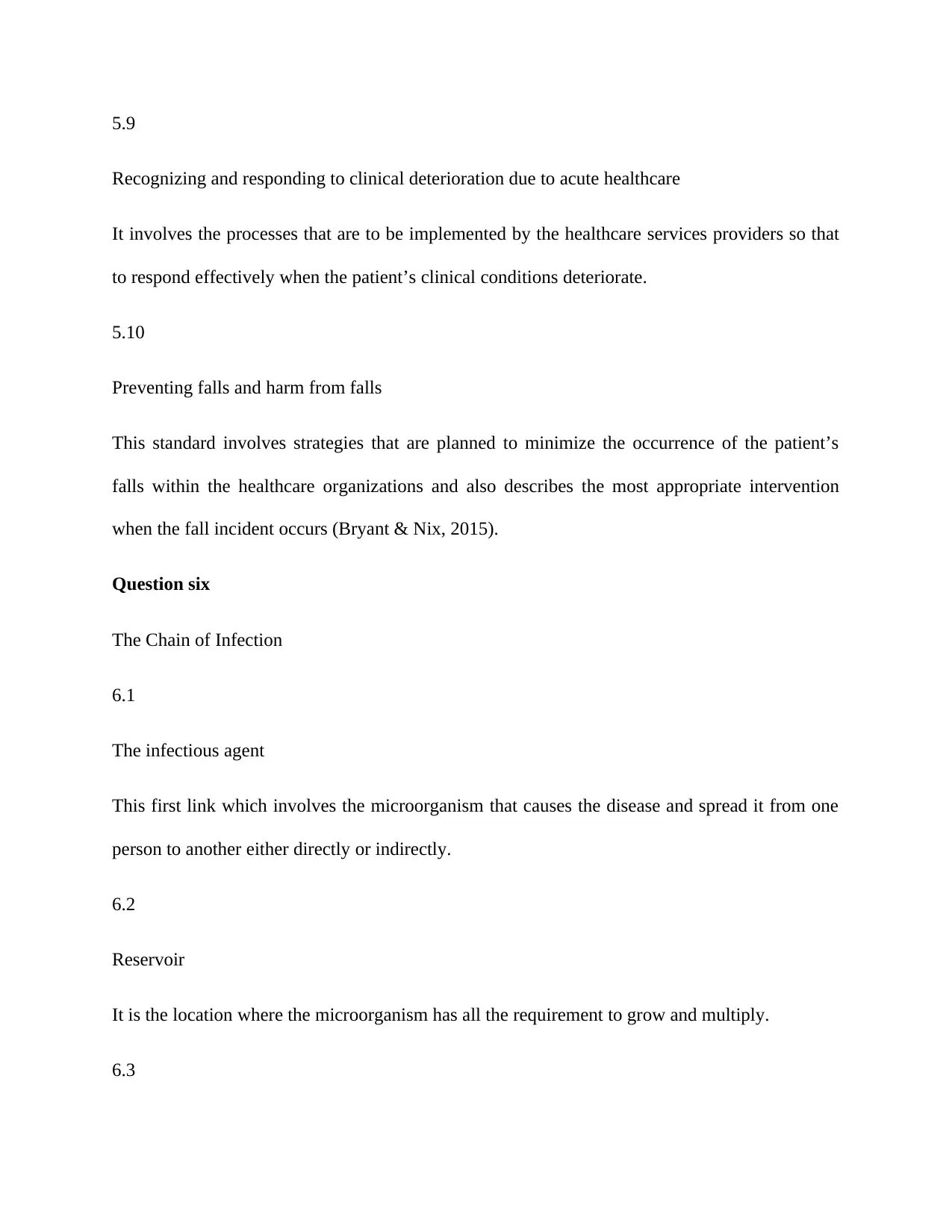
5.9
Recognizing and responding to clinical deterioration due to acute healthcare
It involves the processes that are to be implemented by the healthcare services providers so that
to respond effectively when the patient’s clinical conditions deteriorate.
5.10
Preventing falls and harm from falls
This standard involves strategies that are planned to minimize the occurrence of the patient’s
falls within the healthcare organizations and also describes the most appropriate intervention
when the fall incident occurs (Bryant & Nix, 2015).
Question six
The Chain of Infection
6.1
The infectious agent
This first link which involves the microorganism that causes the disease and spread it from one
person to another either directly or indirectly.
6.2
Reservoir
It is the location where the microorganism has all the requirement to grow and multiply.
6.3
Recognizing and responding to clinical deterioration due to acute healthcare
It involves the processes that are to be implemented by the healthcare services providers so that
to respond effectively when the patient’s clinical conditions deteriorate.
5.10
Preventing falls and harm from falls
This standard involves strategies that are planned to minimize the occurrence of the patient’s
falls within the healthcare organizations and also describes the most appropriate intervention
when the fall incident occurs (Bryant & Nix, 2015).
Question six
The Chain of Infection
6.1
The infectious agent
This first link which involves the microorganism that causes the disease and spread it from one
person to another either directly or indirectly.
6.2
Reservoir
It is the location where the microorganism has all the requirement to grow and multiply.
6.3
Paraphrase This Document
Need a fresh take? Get an instant paraphrase of this document with our AI Paraphraser
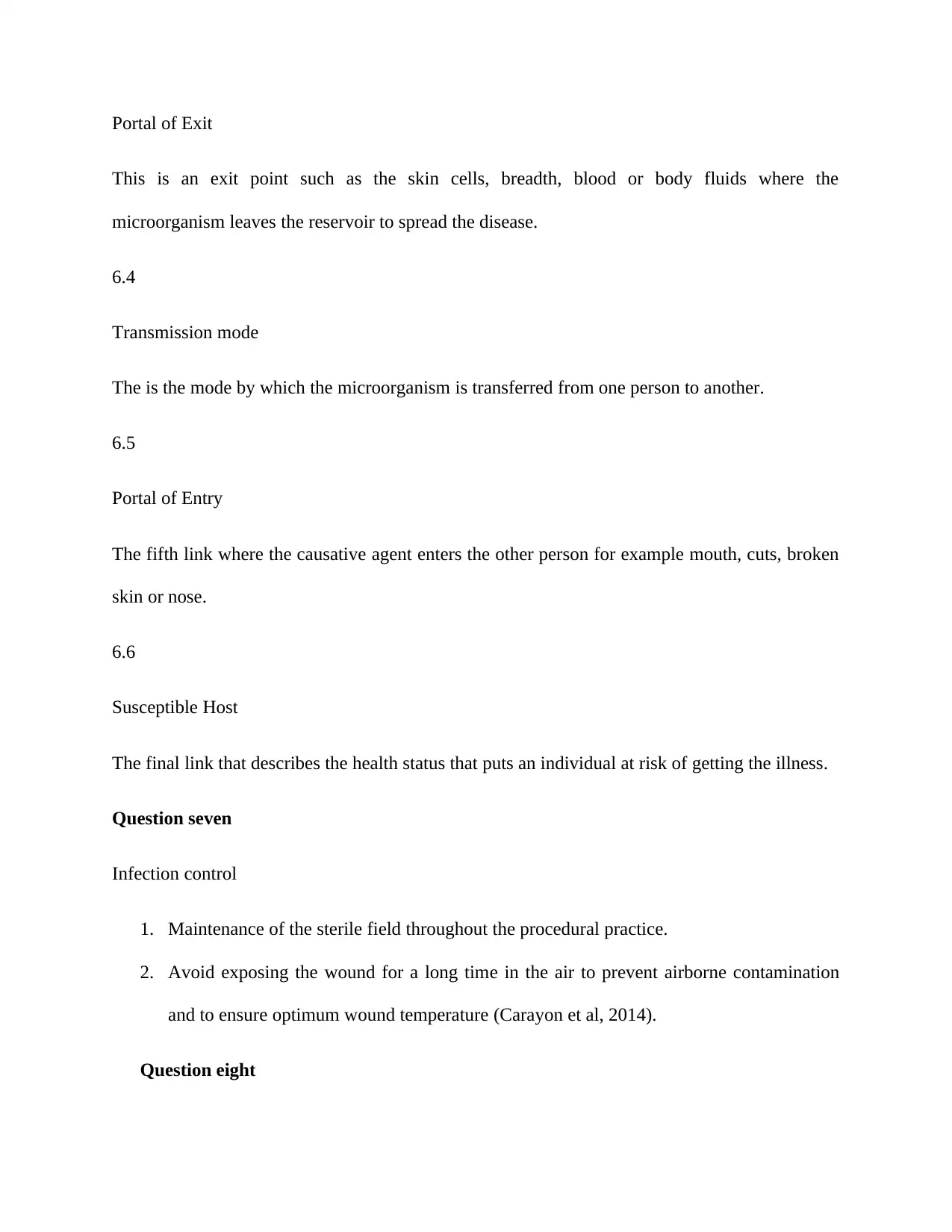
Portal of Exit
This is an exit point such as the skin cells, breadth, blood or body fluids where the
microorganism leaves the reservoir to spread the disease.
6.4
Transmission mode
The is the mode by which the microorganism is transferred from one person to another.
6.5
Portal of Entry
The fifth link where the causative agent enters the other person for example mouth, cuts, broken
skin or nose.
6.6
Susceptible Host
The final link that describes the health status that puts an individual at risk of getting the illness.
Question seven
Infection control
1. Maintenance of the sterile field throughout the procedural practice.
2. Avoid exposing the wound for a long time in the air to prevent airborne contamination
and to ensure optimum wound temperature (Carayon et al, 2014).
Question eight
This is an exit point such as the skin cells, breadth, blood or body fluids where the
microorganism leaves the reservoir to spread the disease.
6.4
Transmission mode
The is the mode by which the microorganism is transferred from one person to another.
6.5
Portal of Entry
The fifth link where the causative agent enters the other person for example mouth, cuts, broken
skin or nose.
6.6
Susceptible Host
The final link that describes the health status that puts an individual at risk of getting the illness.
Question seven
Infection control
1. Maintenance of the sterile field throughout the procedural practice.
2. Avoid exposing the wound for a long time in the air to prevent airborne contamination
and to ensure optimum wound temperature (Carayon et al, 2014).
Question eight
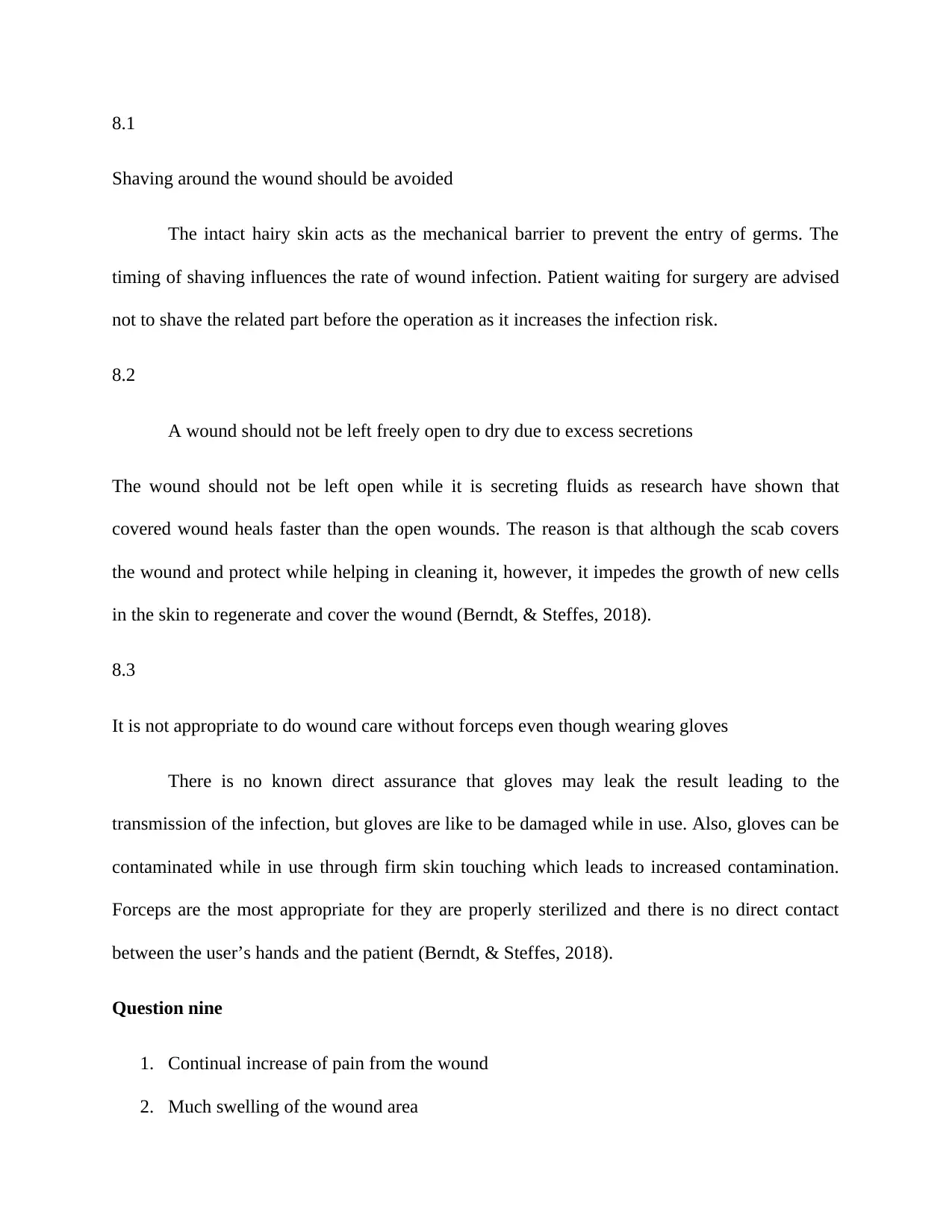
8.1
Shaving around the wound should be avoided
The intact hairy skin acts as the mechanical barrier to prevent the entry of germs. The
timing of shaving influences the rate of wound infection. Patient waiting for surgery are advised
not to shave the related part before the operation as it increases the infection risk.
8.2
A wound should not be left freely open to dry due to excess secretions
The wound should not be left open while it is secreting fluids as research have shown that
covered wound heals faster than the open wounds. The reason is that although the scab covers
the wound and protect while helping in cleaning it, however, it impedes the growth of new cells
in the skin to regenerate and cover the wound (Berndt, & Steffes, 2018).
8.3
It is not appropriate to do wound care without forceps even though wearing gloves
There is no known direct assurance that gloves may leak the result leading to the
transmission of the infection, but gloves are like to be damaged while in use. Also, gloves can be
contaminated while in use through firm skin touching which leads to increased contamination.
Forceps are the most appropriate for they are properly sterilized and there is no direct contact
between the user’s hands and the patient (Berndt, & Steffes, 2018).
Question nine
1. Continual increase of pain from the wound
2. Much swelling of the wound area
Shaving around the wound should be avoided
The intact hairy skin acts as the mechanical barrier to prevent the entry of germs. The
timing of shaving influences the rate of wound infection. Patient waiting for surgery are advised
not to shave the related part before the operation as it increases the infection risk.
8.2
A wound should not be left freely open to dry due to excess secretions
The wound should not be left open while it is secreting fluids as research have shown that
covered wound heals faster than the open wounds. The reason is that although the scab covers
the wound and protect while helping in cleaning it, however, it impedes the growth of new cells
in the skin to regenerate and cover the wound (Berndt, & Steffes, 2018).
8.3
It is not appropriate to do wound care without forceps even though wearing gloves
There is no known direct assurance that gloves may leak the result leading to the
transmission of the infection, but gloves are like to be damaged while in use. Also, gloves can be
contaminated while in use through firm skin touching which leads to increased contamination.
Forceps are the most appropriate for they are properly sterilized and there is no direct contact
between the user’s hands and the patient (Berndt, & Steffes, 2018).
Question nine
1. Continual increase of pain from the wound
2. Much swelling of the wound area
⊘ This is a preview!⊘
Do you want full access?
Subscribe today to unlock all pages.

Trusted by 1+ million students worldwide
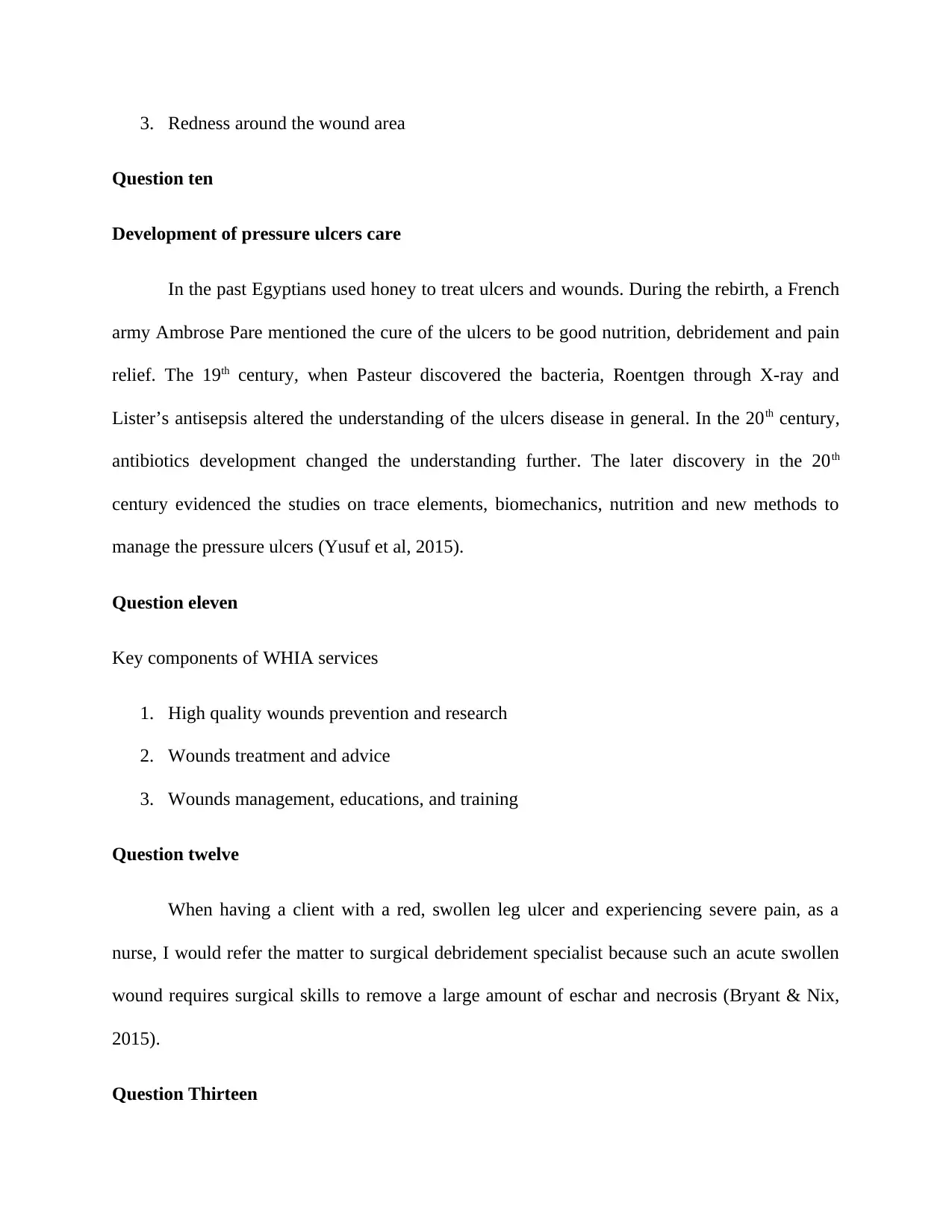
3. Redness around the wound area
Question ten
Development of pressure ulcers care
In the past Egyptians used honey to treat ulcers and wounds. During the rebirth, a French
army Ambrose Pare mentioned the cure of the ulcers to be good nutrition, debridement and pain
relief. The 19th century, when Pasteur discovered the bacteria, Roentgen through X-ray and
Lister’s antisepsis altered the understanding of the ulcers disease in general. In the 20th century,
antibiotics development changed the understanding further. The later discovery in the 20th
century evidenced the studies on trace elements, biomechanics, nutrition and new methods to
manage the pressure ulcers (Yusuf et al, 2015).
Question eleven
Key components of WHIA services
1. High quality wounds prevention and research
2. Wounds treatment and advice
3. Wounds management, educations, and training
Question twelve
When having a client with a red, swollen leg ulcer and experiencing severe pain, as a
nurse, I would refer the matter to surgical debridement specialist because such an acute swollen
wound requires surgical skills to remove a large amount of eschar and necrosis (Bryant & Nix,
2015).
Question Thirteen
Question ten
Development of pressure ulcers care
In the past Egyptians used honey to treat ulcers and wounds. During the rebirth, a French
army Ambrose Pare mentioned the cure of the ulcers to be good nutrition, debridement and pain
relief. The 19th century, when Pasteur discovered the bacteria, Roentgen through X-ray and
Lister’s antisepsis altered the understanding of the ulcers disease in general. In the 20th century,
antibiotics development changed the understanding further. The later discovery in the 20th
century evidenced the studies on trace elements, biomechanics, nutrition and new methods to
manage the pressure ulcers (Yusuf et al, 2015).
Question eleven
Key components of WHIA services
1. High quality wounds prevention and research
2. Wounds treatment and advice
3. Wounds management, educations, and training
Question twelve
When having a client with a red, swollen leg ulcer and experiencing severe pain, as a
nurse, I would refer the matter to surgical debridement specialist because such an acute swollen
wound requires surgical skills to remove a large amount of eschar and necrosis (Bryant & Nix,
2015).
Question Thirteen
Paraphrase This Document
Need a fresh take? Get an instant paraphrase of this document with our AI Paraphraser
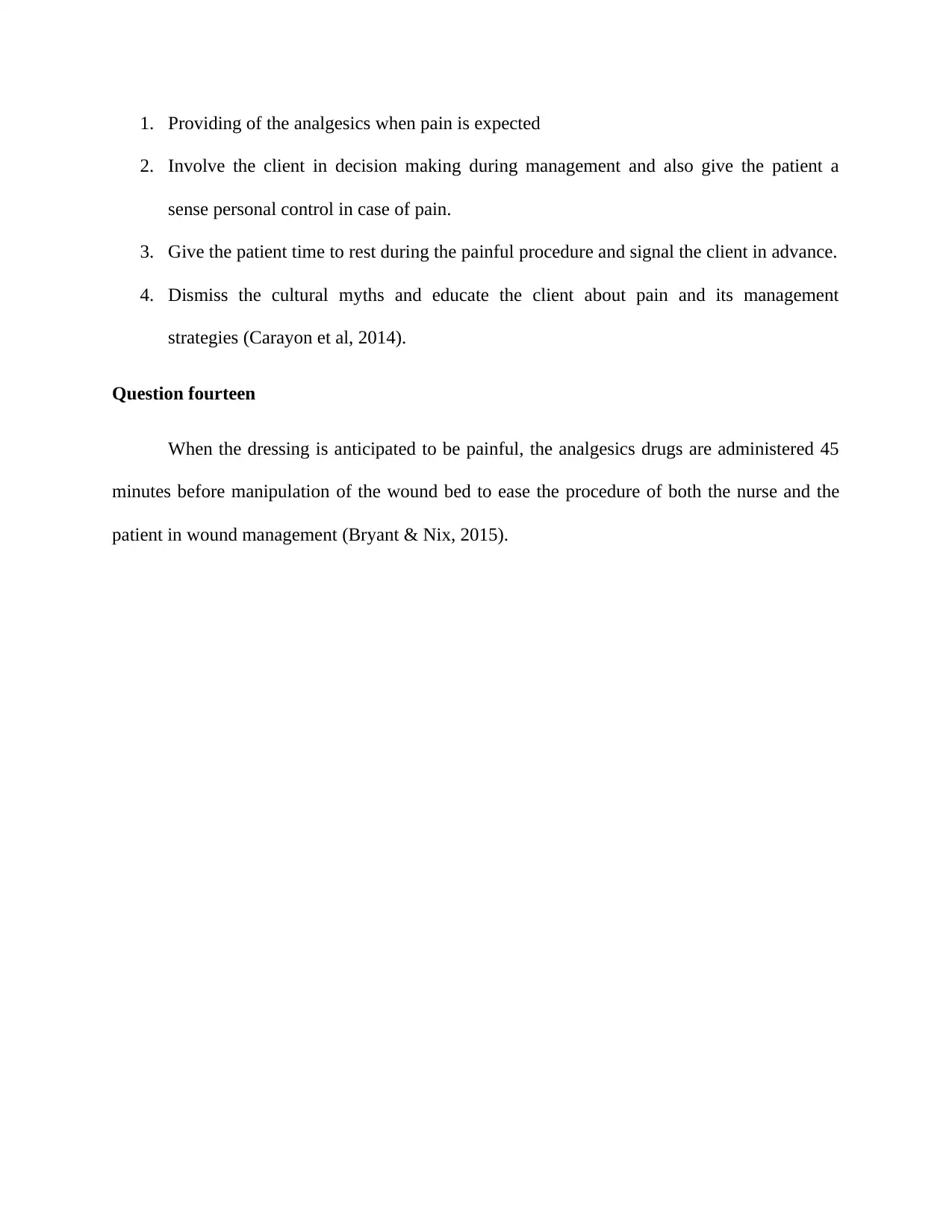
1. Providing of the analgesics when pain is expected
2. Involve the client in decision making during management and also give the patient a
sense personal control in case of pain.
3. Give the patient time to rest during the painful procedure and signal the client in advance.
4. Dismiss the cultural myths and educate the client about pain and its management
strategies (Carayon et al, 2014).
Question fourteen
When the dressing is anticipated to be painful, the analgesics drugs are administered 45
minutes before manipulation of the wound bed to ease the procedure of both the nurse and the
patient in wound management (Bryant & Nix, 2015).
2. Involve the client in decision making during management and also give the patient a
sense personal control in case of pain.
3. Give the patient time to rest during the painful procedure and signal the client in advance.
4. Dismiss the cultural myths and educate the client about pain and its management
strategies (Carayon et al, 2014).
Question fourteen
When the dressing is anticipated to be painful, the analgesics drugs are administered 45
minutes before manipulation of the wound bed to ease the procedure of both the nurse and the
patient in wound management (Bryant & Nix, 2015).
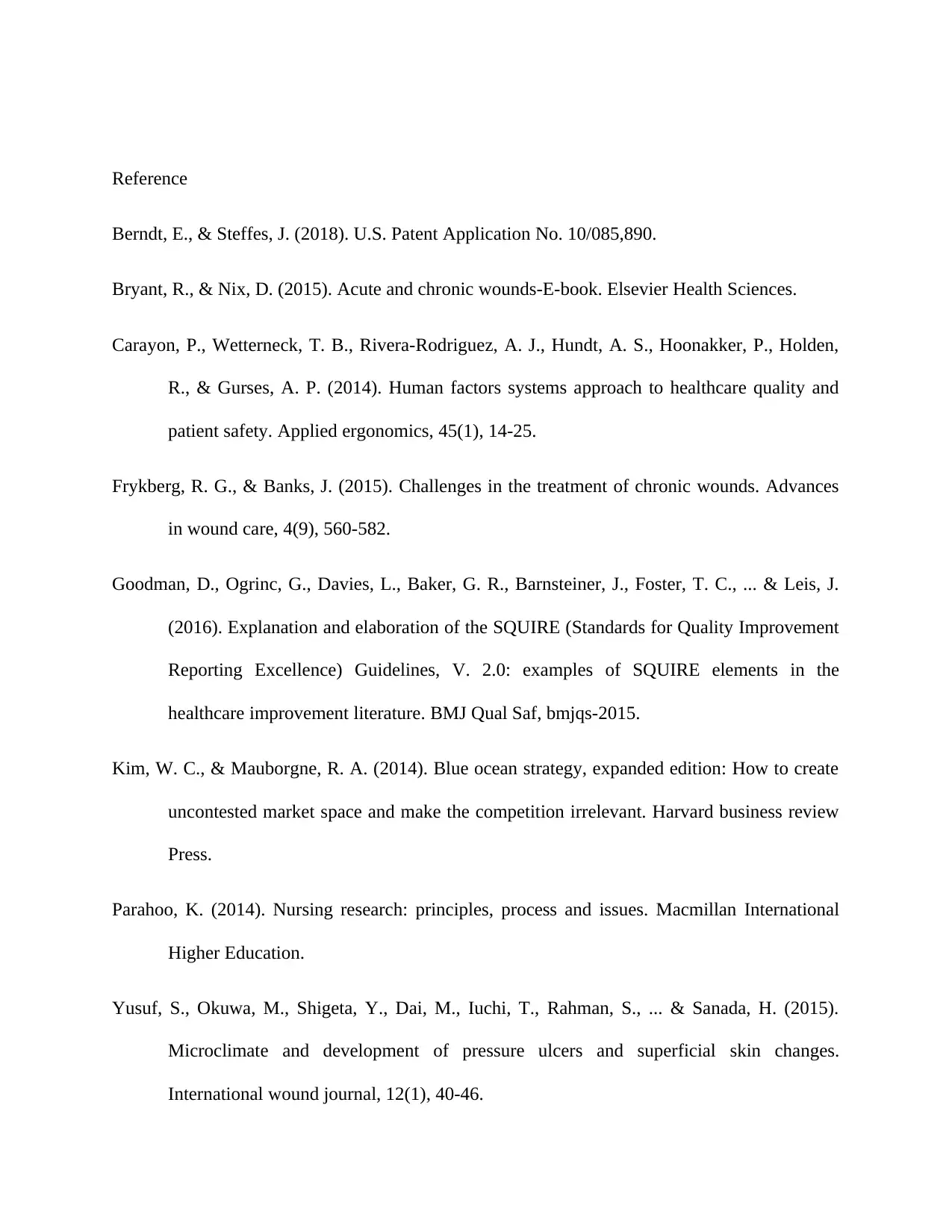
Reference
Berndt, E., & Steffes, J. (2018). U.S. Patent Application No. 10/085,890.
Bryant, R., & Nix, D. (2015). Acute and chronic wounds-E-book. Elsevier Health Sciences.
Carayon, P., Wetterneck, T. B., Rivera-Rodriguez, A. J., Hundt, A. S., Hoonakker, P., Holden,
R., & Gurses, A. P. (2014). Human factors systems approach to healthcare quality and
patient safety. Applied ergonomics, 45(1), 14-25.
Frykberg, R. G., & Banks, J. (2015). Challenges in the treatment of chronic wounds. Advances
in wound care, 4(9), 560-582.
Goodman, D., Ogrinc, G., Davies, L., Baker, G. R., Barnsteiner, J., Foster, T. C., ... & Leis, J.
(2016). Explanation and elaboration of the SQUIRE (Standards for Quality Improvement
Reporting Excellence) Guidelines, V. 2.0: examples of SQUIRE elements in the
healthcare improvement literature. BMJ Qual Saf, bmjqs-2015.
Kim, W. C., & Mauborgne, R. A. (2014). Blue ocean strategy, expanded edition: How to create
uncontested market space and make the competition irrelevant. Harvard business review
Press.
Parahoo, K. (2014). Nursing research: principles, process and issues. Macmillan International
Higher Education.
Yusuf, S., Okuwa, M., Shigeta, Y., Dai, M., Iuchi, T., Rahman, S., ... & Sanada, H. (2015).
Microclimate and development of pressure ulcers and superficial skin changes.
International wound journal, 12(1), 40-46.
Berndt, E., & Steffes, J. (2018). U.S. Patent Application No. 10/085,890.
Bryant, R., & Nix, D. (2015). Acute and chronic wounds-E-book. Elsevier Health Sciences.
Carayon, P., Wetterneck, T. B., Rivera-Rodriguez, A. J., Hundt, A. S., Hoonakker, P., Holden,
R., & Gurses, A. P. (2014). Human factors systems approach to healthcare quality and
patient safety. Applied ergonomics, 45(1), 14-25.
Frykberg, R. G., & Banks, J. (2015). Challenges in the treatment of chronic wounds. Advances
in wound care, 4(9), 560-582.
Goodman, D., Ogrinc, G., Davies, L., Baker, G. R., Barnsteiner, J., Foster, T. C., ... & Leis, J.
(2016). Explanation and elaboration of the SQUIRE (Standards for Quality Improvement
Reporting Excellence) Guidelines, V. 2.0: examples of SQUIRE elements in the
healthcare improvement literature. BMJ Qual Saf, bmjqs-2015.
Kim, W. C., & Mauborgne, R. A. (2014). Blue ocean strategy, expanded edition: How to create
uncontested market space and make the competition irrelevant. Harvard business review
Press.
Parahoo, K. (2014). Nursing research: principles, process and issues. Macmillan International
Higher Education.
Yusuf, S., Okuwa, M., Shigeta, Y., Dai, M., Iuchi, T., Rahman, S., ... & Sanada, H. (2015).
Microclimate and development of pressure ulcers and superficial skin changes.
International wound journal, 12(1), 40-46.
⊘ This is a preview!⊘
Do you want full access?
Subscribe today to unlock all pages.

Trusted by 1+ million students worldwide
1 out of 13
Related Documents
Your All-in-One AI-Powered Toolkit for Academic Success.
+13062052269
info@desklib.com
Available 24*7 on WhatsApp / Email
![[object Object]](/_next/static/media/star-bottom.7253800d.svg)
Unlock your academic potential
Copyright © 2020–2025 A2Z Services. All Rights Reserved. Developed and managed by ZUCOL.





